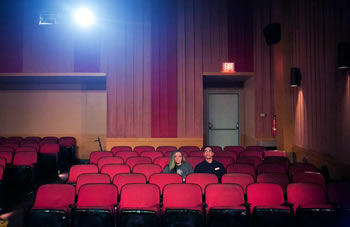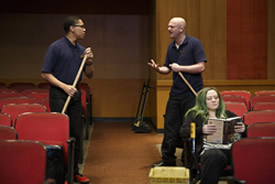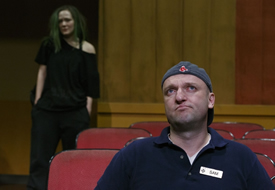
Cinephilia
By Jennifer Cayer
The Flick
By Annie Baker
Playwrights Horizons
(closed)
The Flick’s audience faces an empty movie theater: rows of seats mirroring ours and the red exit sign. Above, a languid ceiling fan refracts ambient light spilling from the projection booth. The outdated cinema, we learn, is on the verge of a corporate buyout and digital makeover. The projector beam takes direct aim at us as portentous music announces the significance of images that we can’t see. The lights rise and two ushers begin to quietly sweep up what is left behind. So begins Annie Baker’s latest collaboration with director Sam Gold: with a quotidian post-show cleanup conversation at a run-down theater in Massachusetts during the summer of 2012. We witness three employees deal with the aftermath of film, from popcorn sacks and candy wrappers, to discarded 35 mm reels and ontological questions Baker asks about the ways we are shaped by media.
The Flick, like Baker’s 2010 play The Aliens, features a trio of outcasts: Sam (Matthew Maher), a 35-year-old veteran usher; Avery (Aaron Clifton Moten), the new hire on a break from college; and Rose (Louisa Krause), a gruff, green-haired projectionist. Sam and Avery develop an easy banter about the best and worst movies of all time and Sam routinely pitches pairs of far-flung Hollywood actors that Avery nimbly connects in repeated games of six-degrees-of-separation. The men’s archival knowledge and love of film quickly foster a friendship. At the same time Sam harbors feelings for Rose, and in a preemptive attempt to curtail a romance, he tells Avery she’s a lesbian. Strangely, Avery expresses little interest in Rose, so there seems to be no reason for Sam to lie to him.
In an interview with Playwrights Horizons artistic director Tim Sanford, Baker emphasized that the main characters are, respectively, a Jew, a black guy, and a woman: three types often rigidly depicted in film history. Avery and Rose admit that they actually see one another as “types” and he complains that everyone acts like they’re on a sitcom; he also confesses to his own discomfiting sense of “faking it all the time.” The triangle of restrained desires beneath these mundane exchanges – which has much to do with the residual shadows and echoes left by the thousands of films projected in the cinema – is the heart of this play. This palimpsestic space of desire is the only one in which we see the characters truly interact.
We are no longer in Shirley, Vermont – the crunchy New England town of Baker’s three previous plays. Still, place, and subtle divides along race and class lines, prominently figure in The Flick. Avery, as he predicts, is ultimately singled out and fired for his reluctant participation in an employee money-skimming scheme. Rose and Sam refuse to admit their longstanding involvement. Rose claims that class difference – she’s not going to college and needs this job – makes her more vulnerable than Avery, a young black college student. In a cruel jab at Sam near the end, Avery says: “I’ll come back to Mass and you’ll still be here cleaning up popcorn and I’ll be, like, living in Paris.” Whereas Baker’s previous plays often ended with optimistic possibilities of being seen anew by others, even strangers, The Flick darkly reveals the alienation resulting from a refusal to recognize our fundamental interdependency. Unlike Circle Mirror Transformation, in which characters improvised new and future lives for one another, Sam, Rose, and Avery tend to make self-serving choices that trump their desires for intimacy. The bright rays of the projector and the exuberant tones of cinematic eventfulness periodically interrupt their more understated struggles for recognition and connection.
Baker registers a generational shift from vinyl to iTunes and from celluloid to digital film. Avery, an advocate for the preservation of film, puts it succinctly: “People freak out when form moves forward.” His concern is not only nostalgic or cerebral: the ease of associations across time enabled by social media is dangerous and destabilizing for him. We learn that his mother reconnected with her high school sweetheart on facebook, subsequently leaving his dad and precipitating Avery’s attempted suicide. In an unusual (for Baker) solo scene, Avery phones his therapist to share a recent dream in which he must name the movie that symbolizes his entire life; he laments his choice of the 1990s comedy Honeymoon in Vegas. That this dream prompts an emergency call to his therapist reveals the seriousness of Avery’s anxieties over the risks of identification and the movies. Among Baker’s plays, The Flick most directly takes on the profound influence of media: both the repertoire of movies and music that we grow up with and how changing media implicitly alter sensory encounters and structure communication.

Within the charged atmosphere of The Flick’s movie theater, akin to Circle Mirror’s windowless theater studio, we watch as each character reckons with the desire to be seen in alternate ways and the uses of certain scripts to that end. Scripts – from songs and personal stories to religious rituals – provide the parameters for performing and re-imagining ourselves. Baker’s characters often perform for one other, re-enacting life stories in Circle Mirror or singing songs in The Aliens, thus making themselves vulnerable to one another’s approving or disinterested gaze. The performances in The Flick are reminiscent of Evan’s out-of-tune, yet impassioned rendition of “If I Had a Hammer” in The Aliens. Like Evan, Rose and Avery speak as if slightly outside of their bodies, with a brittle anxiety about revealing a chaotic core of feeling. In both plays, scripts offer access points to an increased expressive range, with starkly different results.
Rose cajoles Avery into an after-hours private screening. In an effort to romantically bond, she performs a cringe-inducing hip-hop dance. Avery passively watches as she jerkily bops up and down, reeling back and forth to Jay Z’s “I Just Wanna Love U (Give it 2 Me)”:
Now I just wanna love you
But be who I am
[…]
Give it to me
Gimme that funk, that sweet, that nasty, that gushi stuff
But don't bullshit me
The lyrics evoke Rose’s desires to connect in “gushi” yet non-superficial ways. But unlike KJ enthusiastically watching Evan in The Aliens, or everyone gazing in ratifying ways in Circle Mirror and Body Awareness, Avery refuses to join in. In those previous plays, such intra-performances often denoted moments of transformative witnessing where a character was recognized and felt seen by another. Avery’s attempts to assuage Rose’s shame, by contrast, are too late and too weak, and she cuts the music. The Flick’s characters repeatedly contend with the imperative to “be yourself” but have limited scripts and shapes to carry that project out.
An ordinarily subdued Avery also approximates his own anger at Sam and Rose through a script. In lieu of an actual outburst, Avery agrees to perform his practiced impersonation of Samuel L. Jackson’s Ezekial 25:17 speech from Quentin Tarantino’s Pulp Fiction:
The path of the righteous man is beset on all sides by the iniquities of the selfish and the tyranny of evil men. Blessed is he, who in the name of charity and goodwill shepherds the weak through the valley of darkness, for he is truly his brother’s keeper and the finder of lost children. And I will strike down upon thee with great vengeance and furious anger those who would attempt to poison and destroy my brothers.
Coming from Avery, a slight-framed film nerd, these words of Old Testament fury as delivered by Jackson’s self-righteous hit man are amusing. His use of an apt, if extreme biblical reference to the grave risks of human selfishness comprises the apex of his self-expression. But he’s still “faking it.” Earlier, Rose had praised Avery’s ardent letter protesting the corporate takeover of the cinema because it “sounds like something in a movie.” Movies can offer readymade images of self-actualization where latent desires resolve into clear intention, resulting in life-altering actions for one’s self and others. All three characters draw upon the apparent ease of this cinematic resource.
Sitcoms, movies, and songs provide both hackneyed and revelatory scripts for self-expression in The Flick. These performances are set against the yearning for an authentic or unscripted sense of self. Baker’s work consistently foregrounds direct embodied encounters as the hallmark of the theatrical medium and the site of the most transformative encounters within it. It’s no coincidence that Avery’s assertiveness is attached to a Tarantino film. I couldn’t help but recollect the sheer number of violated bodies in Tarantino’s recent film, Django Unchained. The carnage becomes so exaggerated at a certain point that the bodies begin to appear as the popping sacks of stunt blood that they are, rather than vanquished people.

The physical body – the maintenance of its boundaries and threats of its involuntary functions – gets increased attention in The Flick. The conversations are oddly filled with poop, bulimia, and puke jokes. Each character has a heightened sensitivity to bodily functions: Avery has a self-professed “shit aversion” and Sam develops an unexplained rash all over his torso. When Sam finally confesses his feelings to Rose, he suffers severe nausea. Rose callously replies: “sort of seems like it has nothing to do with me, me […] it seems like you’re performing or something.” Rose accuses Sam of possessing feelings that have more to do with fantasies of on-screen romance than with Rose herself. She roughly implores Sam to look at her, to see her apart from his imagined notions, but he continues to face the movie screen.
Both the medium and the physical space of the movie theater – a quintessential date and make-out location – frame and force expectations of intimacy. After Rose’s failed dance party, we watch her screen a film with Avery. She hastily moves to give him a hand job; he doesn’t refuse, or consent. Rose now tries on the role of fast-guy-on-a-date, a part that doesn’t suit her either. As audience members, we may notice that our perception of her abrupt sexual advance might differ if we watched a young man aggressively grope a young woman. Baker draws connections between movie and television roles and social roles along race and gender lines. Such roles, similarly made up, collectively maintained, and pervasive, shape appropriate modes of behavior and are not easily transgressed without consequence. Both Avery and Rose are estranged and deeply humiliated; Avery, head buried in his hands, exclaims “I wanna kill myself,” and Rose recoils, “there’s something wrong with me.”
At the end of the play, Sam begins to train Avery’s replacement, Skylar, using a version of the same script that opened the play. We return to the beginning and a somewhat dulling sense that this will all happen again. After the repeated failures of these three to become more deeply connected to one another, Sam confesses to Avery: “There’s a lot of good stuff in my life. Maybe I never told you about it. Sometimes, people you fall in love with, fall in love with you.” Sam recounts a typical scenario of an unrequited love ultimately reciprocated as something that “really” happens outside the cinema walls. Avery barely acknowledges this faith, another cinematic promise. He ignores the last bid to restore a friendship and leaves, holding cast-off 35 mm reels in hand.
I expected new challenges from The Flick after hearing of the mini-uproar amid Playwrights Horizons patrons because of its three-hour duration and the semi-apologetic tone of the subscriber letter that Sanford wrote in response. I assumed that Baker and Gold had pushed the theatrical effects of silence even further than they did in The Aliens, which was nearly one-third silence and two hours long. Such protracted moments were among the most theatrically resonant, blurring the line between the passivity of conventional spectatorship and a more powerful recognition associated with watching and ratifying the existence of the bodies in front of and beside you. The Flick’s silences, fewer and shorter, replicate natural pauses between the rustlings of work and conversations to pass the time. Whereas previous silences generated a prolonged awareness of the fourth wall, our own investments in upholding it, and the possibilities of crossing it, in The Flick, the imaginary movie-screen-as-fourth-wall is momentarily “touched” only in an ineffectual moment by Avery’s replacement. Skylar reaches toward the screen and the audience, saying: “I always have this urge to touch it, don’t you?” Sam replies with a flat “No” and resumes cleaning.
Compared to Baker’s previous works, The Flick offers a dim view of our reliance on others and the power of cultural roles and popular scripts to offer alternative modes of being and feeling. Baker is not one-sided in her appraisals of our changing relations to media, however. One of the most evocative and visually rich scenes in The Flick cleverly conjoins the distinct mediums and intimacies of live theater and film. Up above the rows of movie seats is the little window of the projection booth. When Rose teaches Avery how to work the projector – fulfilling a longtime dream of his – we watch as if viewing a miniature silent film. We see a quiet choreography of overlapping hands and heads in shadow. Parts of Rose and Avery’s bodies blur in a beautifully understated dance, moving in and out of this little frame within the frame. Without words, this moment approaches the possibility of an unscripted, authentic connection. The duet is rendered at the furthest point from our view, live and yet re-framed, and represents a rare moment where individual bodies overlap and touch in a shared effort to project something.
